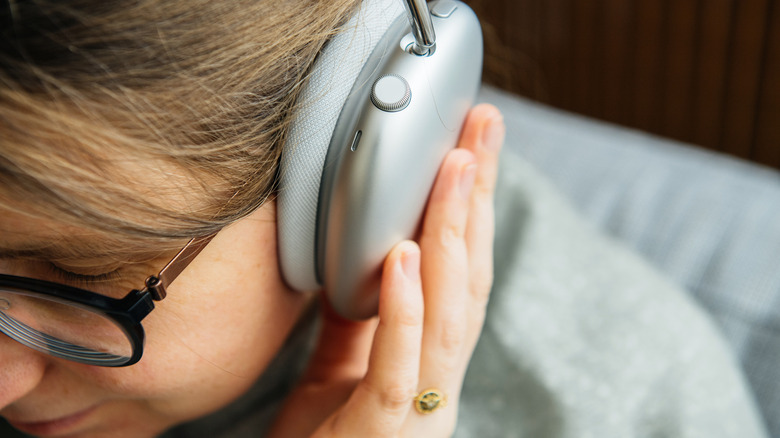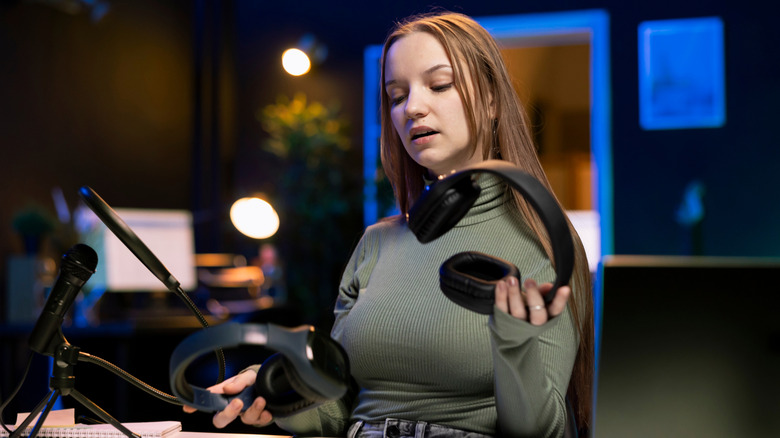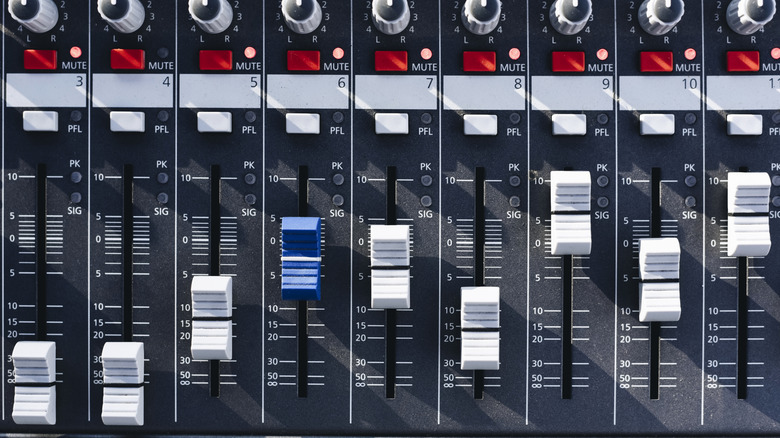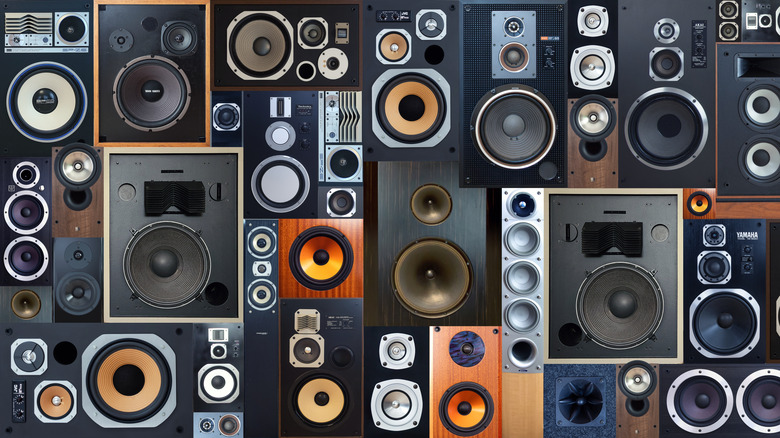How To Find The Best EQ Settings For Your Speaker, Headphones, Or Earbuds
We live in a golden age of audio, where most people are now using higher quality headphones, earbuds, and speakers than ever before. Not only are some of the best headphones and speakers more popular than ever, but people have access to vast, high-fidelity streaming libraries, too. However, if you've ever put on a new pair of headphones, only to find that its default sound profile is too bassy, dull, or otherwise unenjoyable, you'll probably want to equalize, or EQ them to your liking. Equalizing, or "EQing" for short, is the process of correcting imbalances in audio frequencies. It's actually rather simple to EQ your gear, and it's something you can get better at with practice.
As an electronic musician and recovering audiophile who has spent far too many hours tuning, testing, and comparing headphones and speakers, I'm now the friend who will insist on EQing your car speakers when you give me a ride. In accordance with my personal crusade to help people get the best listening experience out of their equipment, I've decided to write the definitive guide for anyone who wants to get the most out of their speakers, headphones, or earbuds but doesn't know where to start. EQing is based heavily on personal preference, and it's more art than science, so this guide aims to give you the broad strokes of the process while also offering tips and tricks you can use to get better results in the long run. So, here's how to find the best EQ settings for speakers, headphones, or earbuds.
Understanding EQing and frequencies
Before we talk about your headphones, let's get some science out of the way. At the most basic level, sound can be understood as existing across a range of audible frequencies known as the audio spectrum. As you may recall from science class, sound is a physical force made up of vibrations through particles as waves, and the longer the distance between each peak of those waves, the lower it is on the audio spectrum. In other words, bass notes are long waves, whereas high pitched sounds are short waves.
Frequencies on the spectrum are measured in Hertz (Hz), which expresses the number of wave oscillations per second. If we ignore 0Hz, which is total silence, the spectrum goes from 1Hz — the lowest possible bass frequency — and increases from there. However, the human ear is only capable of hearing sounds between 20Hz and 20,000Hz, so that's the range covered by a standard EQ. The audio spectrum is usually represented as a graph, which you can see an example of below. You may notice that the graph is logarithmic, which is why the vertical lines on it are not evenly spaced. Frequencies could be expressed non-logarithmically, but that would make the graph unusably large, so instead it gets compressed as frequencies increase. Another reason for logarithmic expression is that the human ear is more sensitive to lower frequencies, so a logarithmic frequency graph allows us to see more detail in the parts of the audio spectrum we can hear better.
When we EQ headphones or speakers, we are simply raising or lowering the volume on different sections of the audio spectrum. Since most EQs don't adjust every individual frequency, they get adjusted in groups known as bands, as pictured below.
Step 1: Identify your preferences
Off the bat, there's no such thing as the "correct" EQ, at least for individuals. If you enjoy hearing so much bass that it crushes the mid frequencies and makes your music sound like it's being played through a broken subwoofer in a 2008 Toyota Camry, then that's how you should set your EQ! Don't let audio snobs yuck your yum. With that said, if you're here because you don't have any strong personal preferences and simply want your music to sound "good" on a technical level, then there are a few different standard EQs most audiophiles will gravitate toward.
First, there's a generic, flat curve. Flat simply means as close to how the recording was mixed in the studio as possible, without any adjustment on your end to bring frequencies up or down. Musicians tend to use flat speakers and headphones in the studio because a flat curve is the most objective way to hear how their music will sound. If you want to hear what an artist heard when they made the song you're listening to, a flat curve is what you should aim for. Personally, a flat curve is what I aim for when EQing my own playback devices.
Next, there's the Harman curve, a specific EQ that supposedly represents the way most people prefer to hear their music. It was created by Samsung-owned audio company Harman by studying and surveying hundreds of listeners, and it consists of a boost to bass and high mid frequencies, with a high roll-off thereafter. This is the EQ that many consumer headphones and IEMs, especially those made by Harman related companies like AKG, adhere to. However, some audiophiles claim it overemphasizes bass and vocals.
Step 2: Understand your gear and software
Once you have a general sense of what you want your audio playback device's EQ to sound like, the next step is to figure out how your speakers or headphones sound out of the box, as well as what EQ options you have. Regarding the first half of that equation, the goal is to figure out how your device is EQed by default so that you know which bands to adjust in the EQ. Do your speakers emphasize one type of sound more than another? Is any part of the frequency band too overpowered or underpowered compared to the rest? If you're having trouble figuring out the expression of your headphones or speakers, you can try listening to one of your favorite songs that you know extremely well, using a studio monitor as a reference if you have one available. Alternatively, you can check online to see if anyone has done professional testing on your particular model of headphones or speaker.
As an illustrative example, here is a professional frequency response test performed by RTINGS for the Sony WH-1000XM5 headphones. Looking at the graph, we can see that it has an extremely overemphasized low end, as well as a dropoff in the high end. For a flat EQ we'll want to start by pulling down the low end and raising the high end.
That brings us to software, which is where your EQing will take place. To continue our example, the Sony WH-1000XM5 headphones have an in-app EQ, but we could also use our phone's universal EQ, or a third-party EQ. These particular headphones can retain EQ profiles set from the app — keeping those settings even when connected to a different device — so the in-app EQ is worth using.
Step 3: Cut overpowering frequencies
One of the easiest beginner mistakes to make while EQing headphones, IEMs, or speakers is to raise levels across the board. This will cause everything to be louder, but not better. Instead, it's best to begin by cutting bands that are overrepresented in the mix. For instance, a lot of consumer headphones are tuned to emphasize bass, which can easily crush your mid frequencies. Beats by Dre used to be notorious for this (though things have improved under Apple's ownership). Instead of boosting the mids to compensate, it's best to drop out those low-end wubs. You can then return them to the mix gradually until they're at a level that feels balanced to you. If you're not immediately noticing a sibilant high-end or honky mids, bass frequencies are usually a great place to start EQing. In addition to being longer waveform frequencies that need more of a deft touch to correct, cleaning up your low end can have a much greater impact on the clarity of the rest of the mix, alleviating what engineers call "muddy" sound.
Once you've identified which frequencies feel the most unbalanced and have lowered those bands severely, you should gradually reintroduce them until they feel in balance. Here, it can be best to go from the high to low end, pushing back up any sharp frequencies you've cut until they feel in accordance, then moving down band by band until you reach the very low end. There's a lot of trial and error involved here, and a lot of personal taste, too, so don't give up if you don't get it right on the first try.
Step 4: Use multiple songs you know well as reference tracks
Again, a fantastic way to get a more objective sense of how your headphones or speakers sound is to listen to songs you know very well. Starting with the bassy instruments, try to pick out each layer of the mix. Is a bass guitar ripping through the song while vocals get pushed to the background? Is a violin caterwauling at ear-piercing volumes that distract from an accompanying piano? One factor to listen for is instrument separation — that is how well each instrument can be heard on its own when you focus on it. If you struggle to hear a major element in the mix, something is wrong. The more you practice analyzing audio in this manner, the easier it will get.
If you have one of the best studio monitors or a pair of headphones that already have a flat EQ to reference against, you can get a more objective sense of what's happening. Play your favorite songs on both the reference device and the device you're EQing, paying close attention to the differences between the two mixes. Of course, most people won't have studio gear, and that's fine. It's a shortcut, but not a necessity.
What is a necessity, however, is to listen to multiple songs on the device you're EQing. An EQ that sounds good on a rock song might sound awful on an EDM or hip-hop song, for instance. Gravitate toward songs mixed by top-tier professionals rather than amateurs. Most chart-topping radio hits from popular artists are produced by industry professionals, and are therefore safe bets. You should also listen to the song in the highest quality format available to you. Avoid Spotify, if possible, as Spotify's audio quality is lackluster compared to other options.
Step 5: Go for zero
After some trial and error, you'll hopefully have a decently balanced mix in your headphones, IEMs, or speakers. You might think you're done at this point, but the next step is to move everything as close to zero dB as possible. This is a pretty simple concept that's hard to communicate without an example, so have a look at the below EQ graph. This is simply an illustrative example, as this EQ wouldn't actually sound good, but it makes for simple math. We've adjusted our two low-end frequency bands down by -3 dB, while moving the mid-high and high frequency bands up by +6 dB. On average, the EQ is therefore +3 dB from zero.
To correct this, we'll move everything down by 1 dB, including the mid frequency band that was at 0 dB after our initial round of EQing. Our two low-end bands now sit at -4 dB, while our two high-end bands are set to +5 dB, and our mid band is now at -1 dB. On average, our EQ is now only +1 dB, which is much closer to baseline than before. You don't have to be totally scientific here, but you should avoid raising or lowering the overall volume too much.
At this point, you're done EQing. It can be helpful to save a screenshot of your EQ settings, just in case you ever have to reset your headphones or speaker, or if you lose the settings for some other reason.
More tips and tricks
Above are the basic steps to EQing, but there are a few more tips and tricks that you might find helpful. First, if you've set an EQ that applies to your entire phone or computer rather than a single device, make sure to turn it off when you're not using the headphones you set it with, as it won't be suited to other playback devices. For advanced EQs, while we covered banded EQs in this guide, you can play around with parametric EQs once you've got the hang of things, as they're much more customizable.
If you'd rather go in the other direction and do less work yourself, and you have a relatively popular pair of headphones or speakers, you can try an EQ app like Toneboosters MorphIt, which will provide a professionally tuned EQ for your device. Once installed on your Mac, iPhone, iPad, or as an add-on inside of USB Audio Player Pro for Android, you can select your headphones, IEMs, or speakers from the app's catalog, then select what sound profile you want to target. For example, you can tune your AirPods Pro to target a generic HiFi or studio curve. Other apps such as Sonarworks SoundID and Wavelet have similar functionality. I know audio professionals who variously swear by all three of these tools. You can experiment with them to figure out which works best for your particular audio playback device.
Lastly, for earbuds or IEMs, ensure that they have a good seal in your ear canals, and that headphones have a good seal over your ears, or that you're sitting in the sweet spot for a pair of speakers. You want to be experiencing the truest sound from your device so that your EQing is as accurate as possible.







